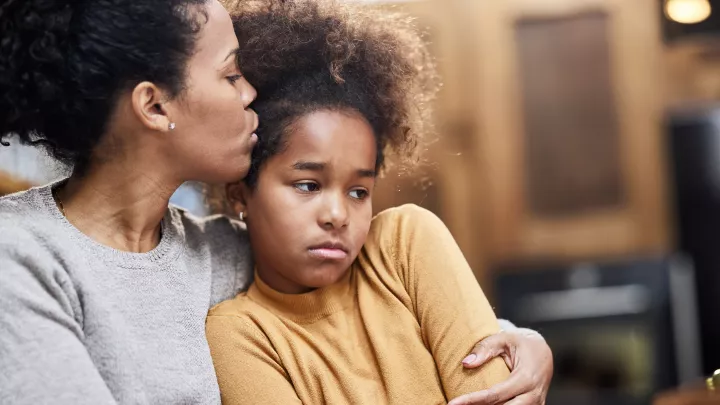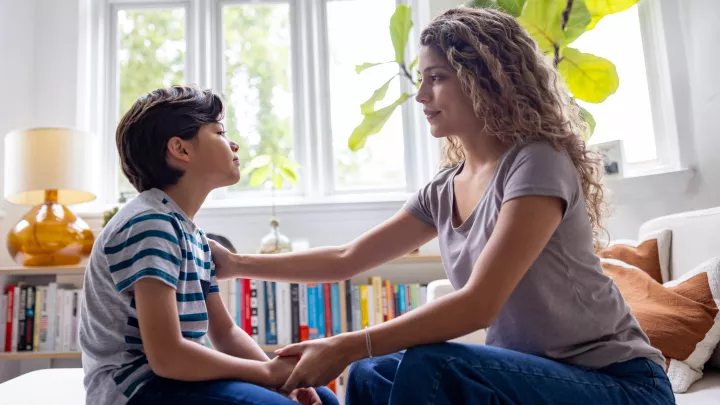
Left to right: Larry Yin, MD, MSPH, Imani Franklin, Olga Solomon, PhD, Alexis Deavenport-Saman, DrPH, MPH, Crystal Ashe, and Susan Gantan, MPH
CHLA to Train First Responders in Helping Individuals With Disabilities During Natural Disasters
First responders are trained to help people through all sorts of emergency situations—but what are the steps they can take to best support individuals with disabilities during a disaster?
Just over a year ago, this was the question that launched a collaboration between the Los Angeles City Fire Department (LAFD), the Advocacy Council and Allies for Deaf Children, and the Children’s Hospital Los Angeles University Center for Excellence in Developmental Disabilities (UCEDD).
The three organizations came together to develop a new curriculum, “Trauma-Informed Response to Children and Adults with Disabilities,” specifically designed to guide first responders in supporting individuals with disabilities during natural disasters, such as this year’s L.A. wildfires. According to the Los Angeles County Department of Public Health, more than one in five adults in L.A. County live with a disability, and this isn’t including the many children and youth in the region who also have disabilities.
Real experiences inform education for future scenarios
The work began when Susan Gantan, MPH, Senior Program Manager of the Office of Community Affairs and Government Relations at CHLA, was contacted by the LAFD. “Susan reached out to us to tap our team’s expertise when the LAFD expressed interest in a collaboration,” explains Alexis Deavenport-Saman, DrPH, MPH, Assistant Director of the UCEDD. The UCEDD includes providers from the Division of General Pediatrics at CHLA. “Then, we connected with the Advocacy Council and Allies for Deaf Children to design some of this curriculum, and that’s really how we got started.”

The curriculum team from CHLA consisted of Dr. Deavenport-Saman, UCEDD Director Larry Yin, MD, MSPH, Olga Solomon, PhD, and Project Coordinators Crystal Ashe, MPH, and Imani Franklin, BS. The team worked primarily with engineer Justin Moore from the LAFD, who had a personal source of inspiration to pursue this partnership. “Justin has a sibling with autism, so he had a very deep understanding of the needs of this population,” Dr. Deavenport-Saman says. “Justin and his family’s lived experience really was an important element guiding this work,” Ashe adds.
The team also incorporated examples and learnings from recent events, such as the story of a young person with cerebral palsy who was unable to get out of his home during the L.A. wildfires. “We compiled real stories involving people with disabilities during disasters to help teach how to best support these individuals and ensure their safety,” Dr. Deavenport-Saman explains.
“The main purpose of the curriculum is to improve first responders’ communication and crisis response skills using trauma-informed care techniques,” Ashe explains. “The curriculum addresses issues such as ableism and discrimination in care, while focusing on reducing escalation and promoting education among first responders.”
The curriculum will eventually be utilized to train all LAFD firefighters to improve their interactions with children and adults with intellectual and developmental disabilities during emergency situations. The goal is to avoid situations in which uninformed emergency care can cause further stress and trauma to people with disabilities who are already experiencing a stressful emergency.
Six main training situations
The curriculum provides specific guidance on evacuating and rescuing individuals with cognitive disabilities, autism, mobility-related disabilities, and special health care needs, along with those who are deaf, hard of hearing, or visually impaired in the following real-world scenarios:
- Car accident that involves an adult with an intellectual and developmental disability
- Incident at home when no one else is present
- Lost or confused individual walking alone down the street
- Individual displaying combative behavior toward their care provider
- Hazardous material (hazmat) evacuation
- Medical emergency
For each situation, the CHLA team provided guidance on how best to respond. “For instance, in a car accident involving someone with an intellectual and developmental disability, we focused on helping responders recognize and effectively communicate with adults who may have difficulty processing the situation they’ve just experienced,” Ashe says.
“We guide responders on how to safely identify and approach a lost person on the street with a disability. And if someone is showing combative behavior toward a care provider, we provide training on de-escalation strategies when a person with a disability is in distress.”
In addition to providing instructive guidance via video clips of real emergencies, audio recordings of actual 911 phone calls, and narrative text, the curriculum also includes more hands-on segments.
“There are some interactive exercises that give the first responders a bit more perspective about how the situation may feel for somebody with a disability who is trying to answer certain questions,” Franklin explains. “These exercises limit the first responders’ senses, such as speaking or hearing, to give them a first-person perspective of what it’s like to answer questions in an emergency if you are speech- or hearing-impaired. We encourage the use of devices and pictures to communicate with individuals who are nonverbal, as well as having an interpreter present for those who are deaf or hard of hearing.”
Bringing the curriculum out into the L.A. community
The curriculum has been completed and finalized, and soon the CHLA team will help train key members of the LAFD. “It’s a ‘train the trainers’ setup,” Dr. Deavenport-Saman explains. “We will start by personally training certain individuals in the fire department who will then take the curriculum and lead multiple trainings with their colleagues.”
“I think as a goal it would be amazing if this curriculum could be utilized nationwide, but as a starting point, the LAFD will be using it in their stations throughout Los Angeles and then trying to see how far the reach can extend from there,” Ashe says. The LAFD comprises 106 fire stations throughout Los Angeles, with over 3,500 firefighters.
“Ultimately, my hope is that with this information and guidance, we can prevent additional traumatic experiences for people who have already gone through a trauma,” Dr. Deavenport-Saman says.
Franklin describes how the development of the curriculum is representative of the UCEDD team’s work overall. “We are working to adjust society to better include people with disabilities. I’m very proud of our staff.”


